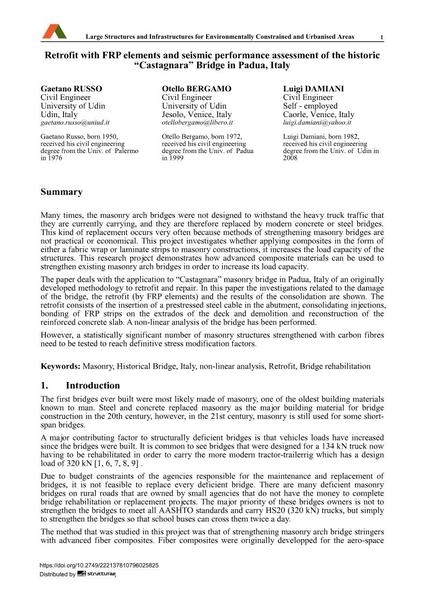Retrofit with FRP elements and seismic performance assessment of the historic "Castagnara" Bridge in Padua, Italy

|
|
|||||||||||
Bibliographic Details
| Author(s): |
Gaetano Russo
Otello Bergamo Luigi Damiani |
||||
|---|---|---|---|---|---|
| Medium: | conference paper | ||||
| Language(s): | English | ||||
| Conference: | IABSE Symposium: Large Structures and Infrastructures for Environmentally Constrained and Urbanised Areas, Venice, Italy, 22-24 September 2010 | ||||
| Published in: | IABSE Symposium Venice 2010 | ||||
|
|||||
| Page(s): | 554-555 | ||||
| Total no. of pages: | 7 | ||||
| Year: | 2010 | ||||
| DOI: | 10.2749/222137810796025825 | ||||
| Abstract: |
Many times, the masonry arch bridges were not designed to withstand the heavy truck traffic that they are currently carrying, and they are therefore replaced by modern concrete or steel bridges. This kind of replacement occurs very often because methods of strengthening masonry bridges are not practical or economical. This project investigates whether applying composites in the form of either a fabric wrap or laminate strips to masonry constructions, it increases the load capacity of the structures. This research project demonstrates how advanced composite materials can be used to strengthen existing masonry arch bridges in order to increase its load capacity. The paper deals with the application to “Castagnara” masonry bridge in Padua, Italy of an originally developed methodology to retrofit and repair. In this paper the investigations related to the damage of the bridge, the retrofit (by FRP elements) and the results of the consolidation are shown. The retrofit consists of the insertion of a prestressed steel cable in the abutment, consolidating injections, bonding of FRP strips on the extrados of the deck and demolition and reconstruction of the reinforced concrete slab. A non-linear analysis of the bridge has been performed. However, a statistically significant number of masonry structures strengthened with carbon fibres need to be tested to reach definitive stress modification factors. |
||||
| Keywords: |
masonry non-linear analysis historical bridge bridge rehabilitation retrofit Italy
|
||||
